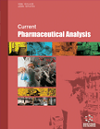
Full text loading...
We use cookies to track usage and preferences.I Understand
The objective of the present work is to develop and validate a novel, specific, precise, and reliable method for the estimation of Calotropis gigantea in bulk and herbal dosage form using the RP-HPLC method.
RP-HPLC analysis was performed using a C18 column of dimension 150×4.6mm, 5 µ. The chromatography system comprised an Agilent 1220 Infinity II LC equipped with a VWD detector and a 1220 Infinity II LC binary pump, wherein the instrument operation was managed through Control Panel software at a flow rate of 0.5 ml/min. Methanol: water in the ratio of 55:45 was used as the mobile phase, and the effluents were analyzed at 275nm. The proposed method was validated for various parameters like linearity, precision, accuracy, robustness, ruggedness, selectivity, limit of detection, limit of quantification, and assay as per the ICH Q2(R1) guidelines.
Linearity was noted over a concentration range of 50-250 µg/ml with a correlation coefficient of 0.999. The limit of detection (LOD) and limit of quantification (LOQ) were determined to be 16.02 and 48.56 µg/mL, respectively. The % RSD for interday and intraday precision studies was less than 2%, which was within the official RSD limit. Recovery analysis performed using marketed formulation was found to be in the range of 97-105%.
The method developed was validated according to the ICH guidelines. Hence, it is evident that the developed method is novel, sensitive, precise, and reliable, and it can be successfully applied to estimate Calotropis gigantea in bulk material and its herbal dosage form.

Article metrics loading...

Full text loading...
References


Data & Media loading...

